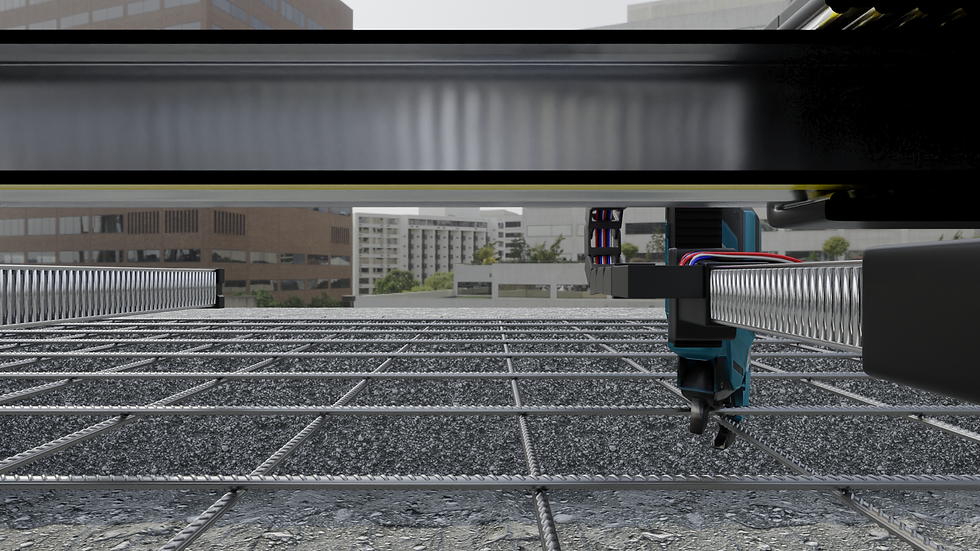TSpider Rebar Knitting Robot: Automating Safety and Speed in Construction
- TSpider

- Aug 3
- 3 min read

Rebar tying is a critical step in reinforcing concrete structures, but it is also one of the most physically demanding and repetitive jobs on a construction site. Workers often spend long hours bent over intersections, making thousands of ties by hand, which leads to fatigue, strain injuries, and reduced productivity as the day progresses. In large-scale projects such as bridges, the sheer number of ties—often in the hundreds of thousands—can significantly slow progress and increase labor costs.
The TSpider rebar knitting robot is designed to change this dynamic. Fully autonomous and equipped with advanced AI, it ties rebar on both horizontal and vertical surfaces without supervision. Its 360° panoramic camera and self-targeting system ensure no intersections are missed, while four tying guns deliver consistent, high-quality results with every step. Built to operate in all weather conditions and compatible with multiple battery types, TSpider offers construction companies a safer, faster, and more cost-effective alternative to manual tying.
The Challenges of Manual Rebar Tying
Manual rebar tying is labor-intensive and time-consuming. On large projects, teams of workers are needed to keep pace with project schedules, yet even with multiple hands on deck, progress can be slow. The repetitive motion required for each tie places strain on the hands, wrists, and back, increasing the risk of injury over time.
Weather conditions add another layer of difficulty. Cold temperatures can reduce dexterity, while extreme heat can accelerate fatigue. On complex structures, such as vertical walls or curved forms, tying can be even more challenging, often requiring awkward positioning and slowing down the work.
For construction companies, these challenges translate to higher labor costs, longer timelines, and the constant balancing act of maintaining both productivity and worker safety.
How TSpider Works on Any Site
TSpider’s design addresses the pain points of manual tying by combining advanced technology with mechanical efficiency. Its four tying guns are integrated into its legs, so each step the robot takes results in multiple secure ties. This unique design not only speeds up the process but also stabilizes the robot as it moves.
The AI navigation system, supported by a 360° panoramic camera, maps the work area in real time, identifying rebar intersections and calculating the optimal route to cover every tie point without redundancy. Whether the structure is horizontal, vertical, or irregular in shape, TSpider can adapt and maintain consistent performance.
Multiple battery options provide flexibility for different jobsite requirements, and the robot’s rugged construction ensures it can operate effectively in rain, heat, or cold. With minimal setup and the ability to work without constant oversight, TSpider integrates smoothly into construction workflows, freeing human workers for higher-value tasks.
Benefits Beyond Speed
While TSpider’s ability to accelerate rebar tying is a major advantage, its impact on jobsite safety and efficiency is equally important. By taking over one of the most repetitive and physically demanding tasks, the robot reduces the risk of musculoskeletal injuries caused by prolonged bending, twisting, and repetitive hand movements. This allows workers to focus on tasks that require skill, problem-solving, and precision—areas where human expertise is most valuable.
The consistency of TSpider’s output ensures that every tie meets quality standards, reducing the likelihood of structural weaknesses caused by missed or poorly executed ties. The robot’s autonomous operation also means that work can continue during periods when manual labor would normally pause, such as under challenging weather conditions or when fatigue slows the pace of workers.
For contractors, this translates into fewer delays, lower labor costs, and more predictable project timelines. Smaller crews can accomplish more in less time, making it easier to meet deadlines without compromising safety or quality.
A Smarter, Safer Future for Construction Sites
TSpider represents a shift in how rebar tying is approached in modern construction. By combining artificial intelligence, mechanical precision, and adaptable design, it delivers faster completion times, consistent quality, and a safer working environment.
Its ability to operate on both horizontal and vertical structures, in all weather conditions, and with minimal supervision makes it a versatile tool for projects of any scale. Beyond speed, TSpider’s greatest value lies in freeing human workers from repetitive strain and allowing them to focus on more complex, higher-impact tasks.
For construction companies looking to improve productivity, reduce injury risks, and stay competitive in a rapidly evolving industry, TSpider offers a practical and forward-thinking solution.




Comentários